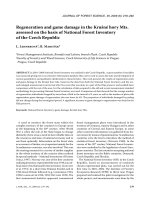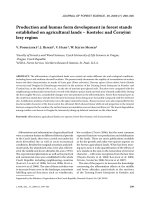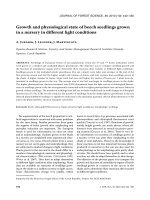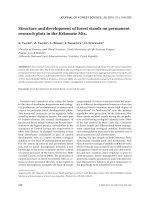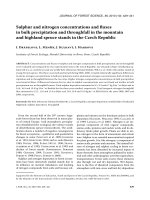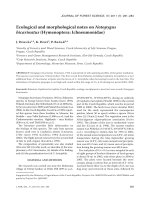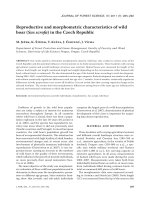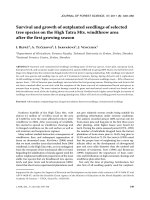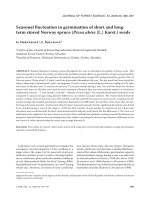Báo cáo lâm nghiệp: "Seasonal and intraspecific variation of frost tolerance in leaves of three Canarian laurel forest tree species" doc
Bạn đang xem bản rút gọn của tài liệu. Xem và tải ngay bản đầy đủ của tài liệu tại đây (147.04 KB, 6 trang )
423
Ann. For. Sci. 62 (2005) 423–428
© INRA, EDP Sciences, 2005
DOI: 10.1051/forest:2005038
Original article
Seasonal and intraspecific variation of frost tolerance in leaves
of three Canarian laurel forest tree species
Águeda Mª GONZÁLEZ-RODRÍGUEZ*, Mª Soledad JIMÉNEZ, Domingo MORALES
Dpto. de Biología Vegetal, Universidad de La Laguna, 38207 La Laguna, Tenerife, Spain
(Received 20 July 2004; accepted 3 March 2005)
Abstract – The effect of freezing temperatures was studied in leaves of three tree species growing in the laurel forest of the Canary Islands,
relictic vegetation of Tertiary Mediterranean flora. The decrease in photochemical capacity of PSII (Fv/Fm) was compared with visual
assessment to determine the degree of frost damage 24 h after treatment. The study was carried out in sun and shade leaves, and in two different
seasons, to obtain information about the intraspecific and seasonal variability of frost resistance of these three species. Our results showed that
the studied species are sensitive to freezing temperatures, Laurus azorica being the most resistant species, undergoing damage at –10 ºC, while
Persea indica and Myrica faya were damaged at –6 ºC and –4 ºC, respectively. In the warm season, sun leaves were less resistant to freezing
temperatures than in the cold season and these leaves showed lower resistance than shade ones. The frost resistance shown by these species was
lower than that of most Mediterranean woody species. However, the existence of other Mediterranean woody plants, with similar sensitivity to
freezing temperatures, indicates that low temperatures were probably not the main cause in the past of their present confinement.
chlorophyll fluorescence / Laurus azorica / Persea indica / Myrica faya / visual damage
Résumé – Variation saisonnière et intraspécifique de la tolérance à la gelée des feuilles de trois espèces arborescentes de la forêt de
laurier des îles Canaries. L’effet du gel a été étudié chez des feuilles de trois espèces d’arbres de la forêt de laurier des îles Canaries, végétation
relique de la flore méditerranéenne du tertiaire. La diminution de la capacité photochimique de PSII (Fv/Fm) a été comparée à l’évaluation
visuelle pour déterminer le degré de dommages de la gelée 24 h après le traitement. L’étude a été effectuée pour les feuilles de lumière et
d’ombre, et à deux saisons différentes, pour obtenir des informations sur la variabilité intraspécifique et saisonnière de la résistance à la gelée
de ces trois espèces. Nos résultats ont prouvé que les espèces étudiées sont sensibles au gel et Laurus azorica est l’espèce la plus résistante qui
subira des dommages à –10 ºC, cependant Persea indica et Myrica faya ont été endommagées à –6 ºC et à –4 ºC, respectivement. Pendant la
saison chaude, les feuilles de lumière étaient moins résistantes au gel que pendant la saison froide et ces feuilles ont montré des résistances
inférieures à celles des feuilles d’ombre. La résistance à la gelée des ces espèces a été plus faible que celle des espèces ligneuses
méditerranéennes. Cependant, l’existence d’autres plantes ligneuses méditerranéennes, avec une sensibilité semblable aux températures de gel,
indique que les basses températures n’étaient probablement pas la cause principale dans le passé de leur confinement actuel.
fluorescence de la chlorophylle / Laurus azorica / Persea indica / Myrica faya / dommages visuels
1. INTRODUCTION
The Canarian laurel forest is a luxuriant vegetation with a
diverse structure of trees, shrubs, herbs, climbers, ferns,
mosses, lichens, and fungi. About 20 tree species belonging to
different families are present in this evergreen forest, the major-
ity of which are Canarian Macaronesian endemics. Trees gen-
erally have broad leaves, always green and glossy, making up
a dense canopy with different anatomical and physiological leaf
characteristics [27]. These forests have the typical appearance
of a cloud forest [16] and are mainly restricted to the most
humid section of the northern (windward) slope in middle ele-
vations where there is an almost permanent cloud belt. They are
relicts of a now virtually extinct Tertiary Mediterranean flora
that occupied southern Europe and North Africa about 20 mil-
lion years ago [10, 37] and disappeared during the Quaternary
glaciations. Knowledge of eventual low temperature effect on
their physiology is of considerable interest since this could be
one of the causes of their present confinement to the Islands
where the climate is milder than that of the Mediterranean
Basin.
It is known that exposure of leaves to temperatures below a
critical level results in irreversible damage to the photosyn-
thetic apparatus [22]. The measurement of chlorophyll fluores-
cence has long been used as a sensitive, reliable, and rapid
method to determine the effect of environmental stresses,
including chilling and freezing stress [4, 6, 8, 32, 33]. Another
method, which has also been used to assess tissue damage due
* Corresponding author:
Article published by EDP Sciences and available at or />424 A.M. González-Rodríguez et al.
to freezing, is the direct observation of visible damage or mor-
tality [5, 7, 21, 23].
The aim of this study is to assess the effect of freezing tem-
peratures on the leaves of three laurel forest tree species grow-
ing in the Canary Islands in order to understand whether the
effect of freezing temperatures in the past could be the cause
of their present confinement. Chlorophyll fluorescence as an
indicator of damage to the photosynthetic apparatus and visual
assessment of damage after freezing were used to evaluate the
effect of low temperatures. Furthermore, the possibility that
damage produced by freezing temperatures showed an
intraspecific variation between leaves exposed in the upper
crown (sun leaves) and in the lower and inner parts (shade
leaves) of the dense canopy of this forest was studied. Lastly,
although this forest presents almost stable microenvironmental
conditions, the eventual seasonal variation of frost tolerance
was tested.
2. MATERIALS AND METHODS
2.1. Plant material
Leaves inserted in the upper and outer crown (sun leaves) and in
the lower and inner parts of the canopy (shade leaves) of Laurus azor-
ica (Seub.) Franco, Persea indica (L.) C. K. Spreng. and Myrica faya
Aiton were collected from dominant, about 37-year old, 18-m high
individuals of these tree species (two trees per species) in an experi-
mental plot of laurel forest situated at an altitude of 820 m a.s.l. on the
Agua García Mountain, Tenerife (further details of the plot in [27–29]).
The climate at the site is humid Mediterranean with a 20-year mean
annual temperature of 14 ºC (absolute maximum and minimum of
39 ºC and 0.2 ºC, respectively), mean relative humidity of 80 %, and
mean annual precipitation of 733 mm per year [11].
Previous climatic studies showed two different seasons at the study
site: one dry and warm season from June to September and another
wet and colder season from October to May [9]. To assess the possible
seasonal variation in the degree of frost tolerance, leaves were taken
during these two different seasons. Sampling months were March in
the cold season and September in the warm season.
Mean temperature in March (cold season) was about 10 ºC, with a
mean maximum and minimum temperature of 14 ºC and 6.5 ºC,
respectively. In September (warm season), the mean temperature was
about 17 ºC and mean maximum and minimum temperatures were
21 ºC and 14 ºC, respectively.
A scaffolding tower in the experimental plot provided access to the
top (sun leaves, 18 m above ground) and to the lower part (shade
leaves, 12 m above ground) of the canopy where whole mature leaves
were detached and immediately transferred to the laboratory. Leaves
were kept overnight in closed chamber with water-saturated air before
exposing them for 30 min in plastic bags in a dark water bath (heat
control: DT Hetotherm, cold control: Hetofrig CB IIe, Heto) to dif-
ferent temperature treatments with steps 2 ºC from 0 ºC to –14 ºC. The
effects of treatments were monitored 24 h after the leaf samples were
left in a closed dark chamber with water-saturated air at room temper-
ature, by chlorophyll fluorescence and by observing visible symptoms.
Six leaves were tested for each temperature treatment and both visual
assessment and measurements of Fv/Fm were performed in the same
leaves.
2.2. Measurement of chlorophyll fluorescence
Room temperature chlorophyll fluorescence of dark adapted leaves
was measured by a time-resolving portable fluorometer (Plant Effi-
ciency Analyser, PEA, Hansatech, UK). Exposure for 2 min to an
actinic light with a flux of 3000 µmol m
–2
s
–1
and a peak wavelength
of 690 nm resulted in the instantaneous measurement of different fluo-
rescence parameters, from which the photochemical capacity of PSII
(Fv/Fm) was determined.
Fv/Fm values measured 24 h after temperature treatment were sta-
tistically analysed using ANOVA with main effects and two-way
interactions. Post-Hoc analyses were realised by Tukey’s test using
P = 0.05 as the critical level of significance. All statistical analyses
were performed using the SPSS (SPSS 11.5 Inc. 2003) package.
2.3. Visual assessment of frost damage
The extent of necrotic patches on the leaves was estimated after full
development of the symptoms. Threshold values for injury were
obtained by visual rating [21], LT
i
being the incipient killing temper-
ature, i.e., the temperature at which injuries first appear, and LT
50
the
temperature at which 50% of leaf area is necrotic.
3. RESULTS
3.1. Chlorophyll fluorescence: Photochemical capacity
of PSII
Values of fluorescence parameters in the studied species
showed a deviation from the normal ones after exposure to low
temperatures. In particular, a decrease in the Fm values and an
increase in Fo values were correlated with a decrease in Fv/Fm
(Fig. 1). Values of this last parameter in response to freezing
temperatures for each studied species are shown in Figure 2.
Statistical analysis of Fv/Fm showed significant differences
(P < 0.001) among the three studied species. An individual sta-
tistical study was subsequently carried out for each species to
determine the effect of the freezing temperature, type of leaf
and season (Tabs. I–III).
Regardless of leaf type and season, a marked difference was
observed in freezing tolerance among species, L. azorica being the
most resistant, followed by P. indica and M. faya. In particular,
Figure 1. Example of variation of initial (Fo, white bar), maximal
fluorescence (Fm, dark bar) and Fv/Fm ratio (square) in response to
freezing temperatures in sun leaves of Laurus azorica in the cold
season. Data represent the mean of six measurements with their stan-
dard deviations.
Frost tolerance of three Canarian laurel forest tree species 425
L. azorica showed damage at –10 ºC, while P. indica and M.
faya were damaged at –6 ºC and –4 ºC, respectively.
Sun leaves were more sensitive to freezing temperatures
than shade ones during the warm season (damage was sustained
2 ºC lower), but no differences were observed in this regard dur-
ing the cold season. Moreover, in all three species leaves were
more sensitive to freezing temperatures in the warm season
with respect to the cold season. In L. azorica the damage tem-
perature LT
i
, was shown to be at –10 ºC and –12 ºC in sun and
shade leaves, respectively, in the warm season. No seasonal dif-
ferences were found in shade leaves. A similar tendency was
observed when damage was studied in P. indica and M. faya,
which showed the same behaviour as L. azorica, with differ-
ences of 2 ºC in sun leaves in the warm season.
Table I. Average values and standard deviations of the Fv/Fm para-
meter in response to freezing temperatures in sun and shade leaves of
Laurus azorica during warm and cold seasons.
L. azorica
Temperature
(°C)
Sun leaf Shade leaf
Warm Season Cold Season Warm Season Cold Season
0 0.84 ± 0.01
a
0.82 ± 0.01
a
0.84 ± 0.00
a
0.83 ± 0.01
a
–2 0.82 ± 0.02
a
0.79 ± 0.09
a
0.84 ± 0.00
a
0.84 ± 0.01
a
–4 0.83 ± 0.02
a
0.82 ± 0.01
a
0.84 ± 0.01
a
0.83 ± 0.01
a
–6 0.84 ± 0.01
a
0.79 ± 0.09
a
0.81 ± 0.02
a
0.84 ± 0.01
a
–8 0.77 ± 0.06
a
0.83 ± 0.03
a
0.84 ± 0.01
a
0.82 ± 0.02
a
–10 0.31 ± 0.06
b,o
0.81 ± 0.05
a,
* 0.82 ± 0.03
a
0.80 ± 0.05
a
–12 0.14 ± 0.0
c,o
0.30 ± 0.11
b,o
0.37 ± 0.03
b
0.69 ± 0.19
a,
*
Letters denote significant differences among temperature treatments
(P < 0.05). Asterisks indicate significant differences between warm and
cold season in the same type of leaf (P < 0.05). Circles indicate
significant differences between sun and shade leaves in the same season
(P < 0.05).
Figure 2. Response to freezing temperatures by upper crown leaves (sun leaves, white circle) and inner crown leaves (shade leaves, dark circle)
in the warm and cold seasons, assessed by the Fv/Fm chlorophyll fluorescence parameter in the tree species Laurus azorica, Persea indica and
Myrica faya. Each point represents the mean of six measurements with their standard deviations.
Table II. Average values and standard deviations of the Fv/Fm para-
meter in response to freezing temperatures in sun and shade leaves of
Persea indica during warm and cold seasons.
P. indica
Temperature
(°C)
Sun leaf Shade leaf
Warm Season Cold Season Warm Season Cold Season
0 0.79 ± 0.04
a
0.85 ± 0.01
a
0.80 ± 0.05
a
0.80 ± 0.04
a
–2 0.82 ± 0.02
a
0.85 ± 0.00
a
0.84 ± 0.03
a
0.83 ± 0.02
a
–4 0.78 ± 0.07
a
0.85 ± 0.01
a
0.86 ± 0.01
a
0.82 ± 0.02
a
–6 0.55 ± 0.09
b,o
0.81± 0.03
a,
* 0.86 ± 0.01
a
0.83 ± 0.02
a
–8 0.19 ± 0.05
c
0.72±0.06
b,
*
,o
0.25 ± 0.14
b
0.51 ± 0.09
b,
*
–10 0.21 ± 0.05
c,o
0.09 ± 0.02
c,
* 0.09 ± 0.00
b
0.10 ± 0.03
c
–12 0.18 ± 0.05
c
0.09 ± 0.02
c,
* 0.10 ± 0.01
b
0.10 ± 0.03
c
Letters denote significant differences among temperature treatments
(P < 0.05). Asterisks indicate significant differences between warm and
cold season in the same type of leaf (P < 0.05). Circles indicate
significant differences between sun and shade leaves in the same season
(P < 0.05).
426 A.M. González-Rodríguez et al.
3.2. Visual damage
Visually assessed damage induced by freezing temperatures
developed gradually. The first symptoms were a blushing of the
main and secondary veins. Then small brown necrotic patches
appeared on the surface of the leaves which, with the decrease
in temperature, covered the whole surface.
In general, damage caused by freezing temperatures was
detected by visual assessment before being measured by the
chlorophyll fluorescence method. The visually estimated dam-
age level showed a similar tendency to those afforded by flu-
orescence techniques, L. azorica being the most resistant
species, and sun leaves and warm season the most sensitive fac-
tors in regard to freezing temperatures (Tab. IV).
4. DISCUSSION
Freezing temperatures affected Fv/Fm ratios in the species
studied. The decrease in Fv/Fm ratio after freezing indicates a
change of photosystem II reaction centres from functional state
to down-regulated or nonfunctional ones [18, 19, 34, 38]. This
represents a disturbance of photosynthetic performance since
photochemical capacity (Fv/Fm) is known to be correlated with
quantum yield of photosystem II [2, 3].
The visual assessment was a sensitive method for detecting
damage caused by freezing temperatures in the three studied spe-
cies. Damage was first detected by this method before fluores-
cence measurements were affected. This is due to the fact that the
initial symptoms of damage were a blushing of the main and sec-
ondary veins and the damage was detected by chlorophyll fluo-
rescence measurements only when the surface of the leaves was
affected. Although this result may seem irrelevant, this behaviour
is not common to all species. For example, in many species, vis-
ually estimated freezing damage correlated well with a decrease
in Fv/Fm [1, 5, 7, 25, 31]. In contrast, the damage in Pinus canar-
iensis was never observed with this assessment [33].
From our results we can conclude that the photosynthetic
apparatus of L. azorica, P. indica and M. faya are sensitive to
freezing temperatures. In general, L. azorica was the most
resistant species, showing damage at –10 ºC, followed by P.
indica and M. faya that were damaged at –6 ºC and –4 ºC,
respectively. Therefore L. azorica is at the lower limit of resist-
ance in the range given by Sakai and Larcher [36] for most Med-
iterranean woody plants such as Laurus nobilis, other
Mediterranean sclerophylls and Mediterranean conifers.
In the case of P. indica, this result agrees with that obtained
in two species of the same genus [20, 23]. M. faya is a more
freezing temperature-sensitive species than its congeners, M.
rubra, a species from subtropical regions, and M. californica,
a species from regions with warm-temperate climates, which
are damaged at –10 ºC and –15 ºC, respectively [36].
In general, sun leaves were less resistant to freezing temper-
atures than shade ones mainly in the warm season and this effect
was more pronounced in L. azorica. Because the high degree of
light adaptation of leaves is usually associated with a higher
stress tolerance [24], our results might seem contradictory.
However, the light adaptation capacity of plants is genetically
fixed and it should be borne in mind that the studied trees are
adapted to very wet and shady habitats, where the laurel forest
is distributed [16]. Nevertheless the leaves which develop in the
upper canopy have to cope with strong light conditions on clear
days [13, 30], therefore only species such as those studied, that
can modify their morphology and physiology to adapt to the
changing conditions along the canopy, are able to grow in this
dense forest [27]. The fact that the photosynthetic apparatus of
sun leaves begins to be affected at much higher temperatures
than shade leaves indicates that the above-mentioned changes
undergone in the sun leaves, including chlorophyll contents and
antenna size, could bring about a greater susceptibility to damage
Table III. Average values and standard deviations of the Fv/Fm para-
meter in response to freezing temperatures in sun and shade leaves of
Myrica faya during warm and cold seasons.
M. faya
Temperature
(°C)
Sun leaf Shade leaf
Warm Season Cold Season Warm Season Cold Season
0 0.85 ± 0.00
a
0.86 ± 0.00
a
0.84 ± 0.02
a
0.86 ± 0.01
a
–2 0.84 ± 0.01
a
0.86 ± 0.02
a
0.84 ± 0.01
a
0.83 ± 0.01
a
–4 0.50 ± 0.22
b,o
0.86 ± 0.01
a,
* 0.82 ± 0.03
a
0.86 ± 0.01
a
–6 0.10 ± 0.06
c
0.36 ± 0.18
b,
*
,o
0.10 ± 0.05
b
0.07 ± 0.01
b
–8 0.05 ± 0.00
c
0.07 ± 0.01
b,
*
,o
0.08 ± 0.04
b
0.06 ± 0.00
c
–10 0.04 ± 0.00
c
0.10 ± 0.01
b,
*
,o
0.06 ± 0.02
b
0.03 ± 0.00
d
–12 0.09 ± 0.01
c
0.08 ± 0.00
b,o
0.08 ± 0.01
b
0.03 ± 0.00
d,
*
Letters denote significant differences among temperature treatments
(P < 0.05). Asterisks indicate significant differences between warm and
cold season in the same type of leaf (P < 0.05). Circles indicate
significant differences between sun and shade leaves in the same season
(P < 0.05).
Table IV. Visual assessment of frost damage in upper crown leaves
(sun leaves) and inner crown leaves (shade leaves) during warm and
cold seasons in Laurus azorica, Persea indica and Myrica faya. Tem-
perature of incipient (LT
i
) and irreversible (LT
50
) damage are shown.
LT
i
is the incipient killing temperature, i.e. the temperature at which
injuries first appear; and LT
50
, the temperature at which 50% of leaf
area is necrotic.
Species Type of leaf Season LT
i
LT
50
L. azorica
Sun Warm –6 –8
Cold –8 –10
Shade Warm –6 –10
Cold –8 –12
P. indica
Sun Warm –4 –6
Cold –7 –8
Shade Warm –7 –7
Cold –6 –8
M. faya
Sun Warm –3 –4
Cold –5 –5
Shade Warm –4 –5
Cold –5 –5
Frost tolerance of three Canarian laurel forest tree species 427
in antenna pigments, although they would be better adapted to
endure higher levels of light. This explanation was also given
to justify similar results obtained in comparable experiments
carried out in sun and shade leaves of the same species but in
relation to dehydration [17], where shade leaves were again
more resistant.
No seasonal variation in the degree of frost tolerance was
observed in shade leaves. Only the sun leaves showed slight
seasonal variations of frost tolerance and this could be due to
the conditions experienced by these leaves in the open canopy.
It should be borne in mind that this forest presents stable micro-
environmental conditions without significant temporal varia-
tions and an acquired freezing resistance with time does not
seem plausible.
The issue to be resolved is why these trees, relicts of a now
virtually extinct Tertiary Mediterranean flora that occupied
southern Europe and North Africa, disappeared from that
region, being presently relegated to the Atlantic islands where
the weather conditions are milder. There are two main con-
straints in the Mediterranean habitat for these plants, cold dur-
ing the winter and drought during the summer. The thermal
crisis of the Pleistocene, with cool periods, probably 5 to 10 ºC
colder than at present, may have forced selection of plants liv-
ing in the Mediterranean regions for low-temperature resist-
ance or for survival in frost-free zones [36]. The three studied
species are freezing-sensitive plants throughout the year and
less frost-resistant than the majority of the Mediterranean
woody species [36], and they seem to have evolved according
to the latter option. Nevertheless there are plants with a similar
range of temperature resistance to the studied tree species that
are actually widespread in the Mediterranean region, for exam-
ple Ceratonia siliqua and Nerium oleander, for which LT
50
val-
ues of –6 ºC and 8 ºC have been reported [36]. Therefore, it is
not clear whether this may be the only cause of their confine-
ment to the Macaronesian region. These tree species are not
very prone to endure arid conditions [26] and field studies on
stomatal behaviour and transpiration [12, 14, 15, 39] showed
their weak ability for physiological regulation of water loss.
Considering that drought stress proves to be the climatic factor
essentially responsible for the restriction of productivity and
survival of woody evergreen plants in Mediterranean-type
regions [35], we think that this could be one of the main causes
of their confinement to the islands, where there are zones in
which the summer drought is mitigated by a persistent cloud
belt, precisely the zones where these trees are living at present.
However, studies focused to find out freezing-induced embo-
lism should be done, since this might also be a physiological
factor affecting past and present distribution of Mediterranean
versus relict species.
Acknowledgements: We wish to thank Juliane Peters, Gilberto Cruz
and María del Carmen González Silgo for their kind assistance during
the experiments. Agueda Mª González-Rodríguez would also like to
express her gratitude to the Consejería de Educación, Cultura y
Deportes of the Canarian Government for a grant which has made this
work possible. This work has been financed by the DGICYT project
No. PB94-0580 (Spanish Government) and the Viceconsejería de
Educación (Canarian Government).
REFERENCES
[1] Adams G.T., Perkins T.D., Assessing cold tolerance in Picea using
chlorophyll fluorescence, Env. Exp. Bot. 33 (1993) 377–382.
[2] Adams W.W., Demmig-Adams B., Winter K., Schreiber U., The
ratio of variable to maximum chlorophyll fluorescence from photo-
system II, measured in leaves at ambient temperature and at 77K,
as an indicator of the photon yield of photosynthesis, Planta 180
(1990) 166–174.
[3] Björkman O., Demmig B., Photon yield of O
2
evolution and chlo-
rophyll fluorescence characteristics at 77 K among vascular plants
of diverse origins, Planta 170 (1987) 489–504.
[4] Boorse G.C., Bosma T.L., Meyer A C., Ewers F.W., Davis D.,
Comparative methods of estimating freezing temperatures and free-
zing injury in leaves of chaparral shrubs, Int. J. Plant Sci. 159
(1998) 513–521.
[5] Boorse G.C., Ewers F.W., Davis S.D., Response of chaparral
shrubs to below-freezing temperatures: acclimation, ecotypes, see-
dlings vs. adults, Am. J. Bot. 85 (1998) 1224–1230.
[6] Brüggemann W., Low-temperature limitations of photosynthesis in
three tropical Vigna species: a chlorophyll fluorescence study, Pho-
tosynth. Res. 34 (1992) 301–310.
[7] Clement J.M.A.M., van Hasselt P.R., Chlorophyll fluorescence as
a parameter for frost hardiness in winter wheat. A comparison with
other hardiness parameters, Phyton 36 (1996) 29–41.
[8] Fernández M., Royo A., Gil L., Pardos J.A., Effects of temperatura
on growth and stress hardening development of phytotron-grown
seedlings of Aleppo pine (Pinus halepensis Mill.), Ann. For. Sci. 60
(2003) 277–284.
[9] García Gallo A., Wildpret de la Torre W., Estudio florístico y fito-
sociológico del bosque de Madre del Agua en Agua García (Tene-
rife), in: Homenaje al Profesor Doctor Telesforo Bravo, Universi-
dad de La Laguna, Secretariado de Publicaciones, 1990, pp. 307–
347.
[10] González Henríquez M.N., Rodrigo Pérez J.D., Suárez Rodríguez
C., Flora y vegetación del archipiélago canario, Edirca, Las Palmas
de Gran Canaria, 1986.
[11] González-Rodríguez A.M., Caracterización fotosintética de árboles
de la laurisilva canaria, Universidad de La Laguna, Tenerife, Spain,
1998.
[12] González-Rodríguez A.M., Morales D., Jiménez M.S., Gas
exchange characteristics of a Canarian laurel forest tree species
(Laurus azorica) in relation to environmental conditions and leaf
canopy position, Tree Physiol. 21 (2001) 1039–1045.
[13] González-Rodríguez A.M., Tausz M., Wonisch A., Jiménez M.S.,
Grill D., Morales D., The significance of xanthophylls and tocophe-
rols in photo-oxidative stress and photoprotection of three Canarian
laurel forest tree species on a high radiation day, J. Plant Physiol.
158 (2001) 1547–1554.
[14] González-Rodríguez A.M., Morales D., Jiménez M.S., Leaf gas
exchange characteristics in relation to leaf canopy position of
Myrica faya in its native environment (Tenerife, Canary Islands),
Plant Biol. 4 (2002) 576–583.
[15] González-Rodríguez A.M., Morales D., Jiménez M.S., Leaf gas
exchange characteristics of a Canarian laurel forest tree species
Persea indica (L.) K. Spreng. under natural conditions, J. Plant
Physiol. 159 (2002) 695–704.
[16] Hollermann P., Microenvironmental studies in the laurel forest of
the Canary Islands, Mt. Res. Dev. 1 (1981) 193–207.
[17] Jiménez M.S., González-Rodríguez A.M., Morales D., Effect of
dehydration on the photosynthetic apparatus of sun and shade lea-
ves of laurel forest trees, Z. Naturforsch. C54 (1999) 704–710.
[18] Krause G.H., Photoinhibition and photosynthesis. An evaluation of
damaging and protective mechanisms, Physiol. Plant. 74 (1988)
566–574.
[19] Krause G.H., Grafflage S., Rumich-Bayer S., Somersalo S., Effects
of freezing on plant mesophyll cells, in: Long S.F., Woodward F.I.
(Eds.), Plants and Temperature, Comp. Biol. Ltd., Cambridge,
1988, pp. 311–327.
428 A.M. González-Rodríguez et al.
[20] Larcher W., La posizione delle piante sempreverdi mediterranee
nella evoluzione della resistenza al freddo. Atti dell’Istituto Veneto
di Scienze, Lettere ed Arti 138 (1980) 103–111.
[21] Larcher W., Vitalitätsbestimmung, in: Kreeb K.H., Fischer G.
(Eds.), Methoden zur Pflanzenökologie und Bioindikation, 2. Aufl.,
Jena, 1990, pp. 251–265.
[22] Larcher W., Physiological Plant Ecology, 4th ed., Springer-Verlag,
Berlin-Heidelberg-New York, 2003.
[23] Larcher W., Wagner J., Neuner G., Méndez M., Jiménez M.S.,
Morales D., Thermal limits of photosynthetic function and viability
of leaves of Persea indica and Persea americana, Acta Oecol. 12
(1991) 529–541.
[24] Lichtenthaler H.K., Vegetation Stress: an introduction to the stress
concept in plants, J. Plant Physiol. 148 (1996) 4–14.
[25] Lindgren K., Hällgren J.E., Cold acclimation of Pinus contorta and
Pinus sylvestris assessed by chlorophyll fluorescence, Tree Phy-
siol. 13 (1993) 97–106.
[26] Lösch R., Water relations of Canarian laurel forest trees, in:
Borguetti M, Grace J., Raschi A. (Eds.), Water transport in plants
under climatic stress, Cambridge Univ. Press, Cambridge, 1993,
pp. 243–246.
[27] Morales D., González-Rodríguez A.M., Cermák J., Jiménez M.S.,
Laurel forests in Tenerife, Canary Islands: The vertical profiles of
leaf characteristics, Phyton 36 (1996) 251–263.
[28] Morales D., Jiménez M.S., González-Rodríguez A.M., Cermák J.,
Laurel forests in Tenerife, Canary Islands. I. The site, stand struc-
ture and stand leaf area distribution, Trees 11 (1996) 34–40.
[29] Morales D., Jiménez M.S., González-Rodríguez A.M., Cermák J.,
Laurel forests in Tenerife, Canary Islands. II. Leaf distribution in
individual tree, Trees 11 (1996) 41–46.
[30] Morales D., González-Rodríguez A.M., Tausz M., Grill D.,
Jiménez M.S., Oxygen stress and pigment composition in Canarian
laurel forest trees, Phyton Ann. Rei. Bot. A. 37 (1997) 181–186.
[31] Neuner G., Buchner O., Assessment of foliar frost damage: a com-
parison of in vivo chlorophyll fluorescence with other viability
tests, J. Appl. Bot. 73 (1999) 50–54.
[32] Öquist G., Hurry V.M., Huner N.P.A., The temperature depen-
dence of the redox state of Q
A
and susceptibility of photosynthesis
to photoinhibition, Plant Physiol. Bioch. 31 (1993) 683–691.
[33] Peters J., Jiménez M.S., Morales D., Effect of extreme temperatures
on quantum yield of fluorescence and membrane leakage of the
Canarian endemic pine (Pinus canariensis), Z. Naturforsch. 54
(1999) 681–687.
[34] Powles S.B., Photoinhibition of photosynthesis induced by visible
light, Annu. Rev. Plant Physiol. 35 (1984) 15–44.
[35] Roy J., Aronson J., di Castri F., Time scales of biological responses
to water constraints. The case of Mediterranean biota, SPB Acade-
mic Publ., Amsterdam, 1995.
[36] Sakai A., Larcher W., Frost survival of plants. Responses and
Adaptation to freezing stress, Ecological Studies, Vol. 62, Sprin-
ger-Verlag, 1987.
[37] Santos A., Evergreen forests in the Macaronesian region, Council
of Europe, Strasbourg, 1990.
[38] Somersalo S., Krause G.H., Effects of freezing and subsequent light
stress on photosynthesis of spinach leaves, Plant Physiol. Bioch. 28
(1990) 467–475.
[39] Zohlen A., González-Rodríguez A.M., Jiménez M.S., Lösch R.,
Morales, D., Transpiración y regulación estomática en árboles de la
laurisilva canaria medidos en primavera, Vieraea 24 (1995) 91–
104.
To access this journal online:
www.edpsciences.org
